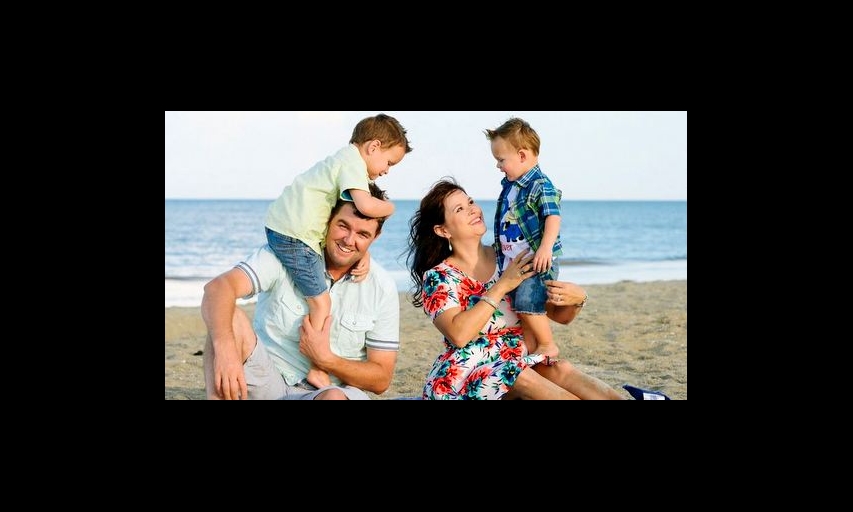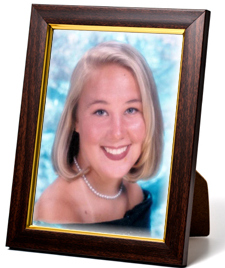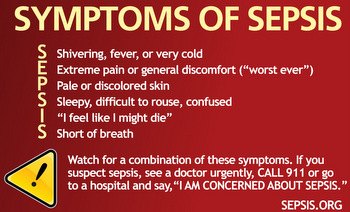Marc & Audrey Leishman Committed To Raising Sepsis Awareness
- Details
- Category: Inside Golf
- Published: 2017-02-11

The Leishman Family (Photo/Leishman Family)
(Doug Milne/PGA TOUR Staff) — Dr. Carl Flatley’s daughter wasn’t expected to die.
Marc Leishman’s wife wasn’t expected to live.
But despite the dichotomy of those expectations for two men who had never met, their lives became permanently intertwined.
A retired dentist from Dunedin, Fla., Dr. Flatley made a career of root canals that lasted nearly three decades. As such, he was all too familiar with blood and infections. Or, so he believed.
In late April of 2002, his daughter, Erin, underwent a hemorrhoidectomy, a routine surgical procedure done on an outpatient basis.

“She was as healthy as can be,” Dr. Flatley remembered. “In fact, I had bought her a jet ski the day before, for when it was all over as a symbol of how bright the future was going to be.”
Four excruciatingly painful days later, at the age of 23, Erin Flatley was dead. The cause of death was deemed to be septic shock syndrome.
“She had just gotten out of college and had her whole life ahead of her,” Dr. Flatley said. “She was as happy as can be.”
Stunned, Dr. Flatley embarked on a tireless mission to learn more about a disease he came to know as sepsis. The colloquial term for sepsis is blood poisoning. Realizing his daughter’s life was taken by something no-one knew about or understood, he began the American Sepsis Alliance in 2004. In 2007, with full governance, the advocacy group, based in San Diego, Calif., became known as the Sepsis Alliance.
“We are now the leading advocacy group against sepsis,” Dr. Flatley said. “I started by myself with nothing but passion. We were a start-up organization that has grown. I have put well over $1 million of my own money, much from my retirement, into this. All of our Board of Directors are volunteers. We only have a few paid employees, so we have a very low overhead. I couldn’t be more proud of what we have achieved. We have physicians, nurses and attorneys on our board.”
The mission of Dr. Flatley’s creation was then – and remains today – to educate the public on what he said has become the third-leading cause of death in the United States.
“Someone asked me once why I decided to start the Sepsis Alliance,” Dr. Flatley said. “I told them I didn’t decide to start it, it selected me to start. I practiced dentistry. I did root canals for 25 years. Before that, I was in the service, Vietnam. I never, ever in my training once heard the word sepsis.”
It’s Dr. Flatley’s contention that 80 percent of sepsis cases are preventable. With vaccinations, attention to cleanliness and a basic understanding of the disease, sepsis wouldn’t claim the staggering number of lives it does. More common than heart attacks, sepsis occurs when the body’s efforts to fight infections result in the immune system’s widespread damage of organs and tissues. Simply, the body’s natural reaction to help save a life very often ends a life.
“Since losing my daughter in 2002, more than 3.5 million people have died from sepsis in the United States,” Dr. Flatley said. “Think about it. 3.5 million in 15 years. I’m not making light of cancer in any way, but breast cancer claims 50,000 lives a year. Sepsis claims five times that amount in the same time frame.”
Dr. Flatley explained that if an individual dies from infection, said individual, in fact, dies from sepsis.
“The flu, pneumonia, an infected knee or even a cut on the finger….it’s sepsis,” he said. “It was reported that Mary Tyler Moore died of pneumonia. It was sepsis. Muhammad Ali was reported to have died of Parkinson’s. Not true. He died of sepsis. Christopher Reeve, Jim Henson. All sepsis. We lose 30 people an hour to it.”
The question then begs that if sepsis is the camouflaged culprit of so many deaths, why is it not being confronted much more aggressively and featured in every medical journal.
{youtube}CVzYKN1BpsM{/youtube}
“One of the physicians on our board believes that only about 10 percent of doctors even say the word, because if they say it, they have to explain it to the patient who has never heard of it,” Dr. Flatley said. “They classify it as ‘complications.’ No-one knew anything about Sepsis and, therefore, no-one was doing anything about it.”
When the Sepsis Alliance officially began 10 years ago, Dr. Flatley said that only 17 percent of the population in the United States was aware of sepsis. People who had heard the word, he contended, couldn’t really explain it. Today, awareness is up to 55 percent.
The silver lining to a close call – bordering on fatal – for PGA TOUR member Marc Leishman and his wife Audrey, is an awareness of sepsis.
In April of 2015, Audrey felt herself coming down with what seemed to be just a bad cold. Like Dr. Flatley’s daughter, Audrey was in perfect health. But, when her alarming temperature of 102 didn’t relent after two days, she went to a doctor. With a blood pressure that had dropped to 90/30 and a heart rate in the 140s, doctors considered sepsis. She was rushed to the hospital, where she became unable to breathe on her own.
Marc was told to plan for the unthinkable.
“All I remember was a number of hanging antibiotic bags, with fluids being injected into her,” Leishman said. “Eventually, we were told it was too late. They told us she was going to die. But, somehow, she survived. It happens very quickly. We were lucky with the doctors we had, because they did know about sepsis and could respond accordingly.”
Upon tracing their steps back, complications from a blood-related issue earlier in the week for Audrey had, in fact, been the onset of the medical emergency.
Audrey was among the lucky few stricken with sepsis. She lived.
“A lot of people just don’t know to suspect it,” Dr. Flatley said. “So, by the time you go to the hospital, it’s almost too late. That was the case with Audrey. What the Sepsis Alliance is doing, and the award we presented Audrey with last year, is getting awareness out there. You’ve got to at least mention it to the doctor. If you’re on top of it and get it early, it’s easy to fix. But, if you let it go too long, it’s impossible to fix.”
Following the ordeal, the Leishmans began the Begin Again Foundation, which provides finances to families in need of help with payment for medical emergencies.
“When I heard about the Leishmans and what they were doing, we established the Erin K. Flatley Spirit Award,” said Dr. Flately. “When it came to Audrey, who survived sepsis, I wanted to honor someone who not only did their job, but who went above and beyond to give back. What they are doing is remarkable.”
“What Dr. Flatley is doing is amazing,” said Leishman. “We went to New York to accept the award. Audrey got it for surviving and then helping get the word out there about sepsis. We met a lot of survivors, which was amazing, because you don’t get to meet many survivors. For her to discuss recovery was huge. It’s amazing what they are doing.”
“If a patient is given antibiotics and fluids within the first hour, you have an 80 percent chance of survival,” Dr. Flatley said. “For every hour after that, your chance of surviving drops eight percent. Yet, only 50 percent of the hospitals in the United States use that protocol. It’s staggering. The older doctors are not educated on it and they aren’t going to change. The younger doctors and nurses do have more of an awareness of it. So, our organization is out to educate nurses, because they are usually the first line of defense. But, our primary target is to educate the public.”
Education is the pivotal word when describing the Alliance. The Alliance does not treat, but acts as an advocate group to get word out that sepsis is a medical emergency. Just this year, the Society for Critical Care Medicine classified sepsis as a medical care emergency. But, as was the case with his daughter in 2002, a lack of education across the board continues to be the smoking gun.
“When my daughter was in the hospital, she wasn’t considered an emergency, because she looked ok,” Dr. Flatley said. “She wasn’t bleeding, didn’t have bruises or cuts. She had an infection, but it wasn’t showing. So, they had her sit there for six hours. So, that’s six times eight percent. Her chance of dying went up 50 percent, just because they made her wait.”
According to Dr. Flatley, the government has now involved itself upon the realization that sepsis is the most expensive disease billed to Medicare. Hospitals are now beginning to be penalized for due diligence failure. Regardless of how sepsis is making its way to the radar, Dr. Flatley sees hope for the future.
“I retired in 1995, having done 33,000 root canals,” he said. “At the time, I looked back and thought ‘Wow, I’ve really accomplished something.’ But, I can tell you, if the Sepsis Alliance has helped touched or saved only one life, it would surpass every single one of those root canals. It has been more significant doing this than all those years working on teeth.”

“It’s unreal what he has done,” Leishman said, who finished T24 at last week’s Waste Management Phoenix Open. “I hope he continues to get a lot of support and can really raise awareness. It’s something everyone needs to be aware of, because it is so serious.”
“Many people still can’t really explain it, but at least we’re making tremendous progress,” Dr. Flatley said. “If I died tomorrow, I could say I have achieved my mission. But, there’s still a long way to go. And, through this, the memory of my daughter will live on.”
So, too, will Audrey Leishman.
To learn more about Dr. Carl Flatley and the Sepsis Alliance, log on to sepsis.org.
To learn more about Marc and Audrey Leishman’s story and foundation, visit beginagainfoundation.com.



